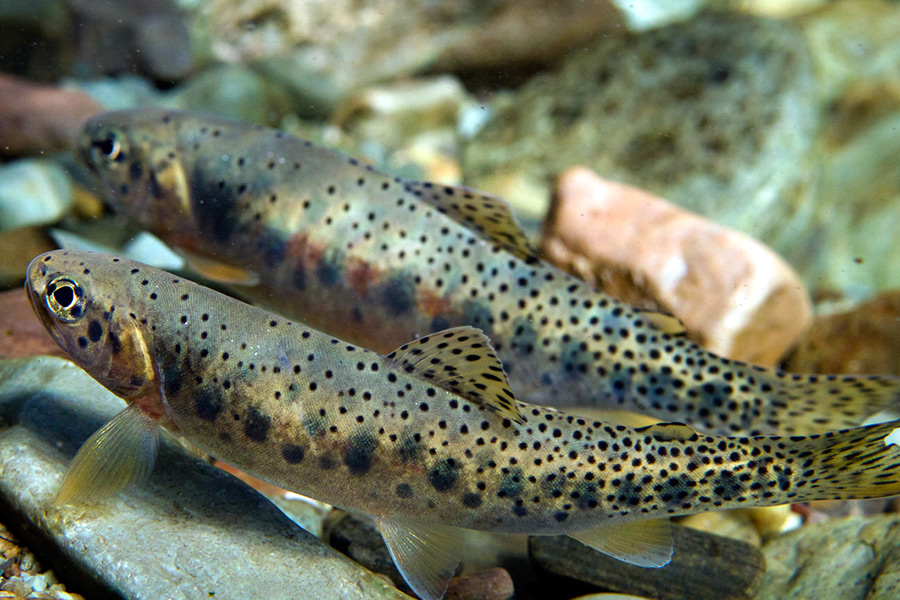State fisheries managers are asking for the public’s feedback on a proposed conservation project aimed at restoring native westslope cutthroat trout populations in Rainbow Lake, an alpine jewel situated on a drainage of the Wigwam River near Eureka, where hybridization with nonnative fish has imperiled the prized species in a region considered their last best stronghold.
The proposed project is in Lincoln County, approximately 11 miles northeast of Eureka, and calls for stocking the mountain lake with genetically pure strains of the native trout species. However, the architects of the project must first remove non-native Yellowstone cutthroat trout that have infested the drainage by using a fish toxicant called rotenone, which is extracted from the roots of several plant species in the legume family and is lethal to gill-breathing creatures.
According to a draft environmental assessment submitted by Montana Fish, Wildlife and Parks (FWP), the chemical treatment of Rainbow Lake would have “short-term, minor effects on wildlife, recreation and vegetation,” and would be limited to the lake and approximately one mile of tributary downstream from its outlet. If the project moves forward, public access to Rainbow Lake would be temporarily closed during the period of rotenone treatment, which FWP expects to take no more than four days to one week. FWP would coordinate all access closures with the U.S. Forest Service Rexford Ranger District at least one week prior to the project’s implementation, according to officials.
The application of rotenone as a piscicide to treat lakes for invasive species has gained wider acceptance in recent years as a safe and effective conservation tool, particularly as the plight of native trout species has gained urgency.
Widespread hybridization of westslope cutthroat trout with nonnative trout species, such as Yellowstone cutthroat and rainbow trout, has been widely documented in the Flathead River drainage, as well as in portions of the Swan River basin and now in the upper Kootenai River basin. As a result, westslope cutthroat trout have experienced marked reductions in numbers and distribution throughout the species’ historic range, which includes the upper Kootenai basin where Rainbow Lake is located, according to FWP.
“Securing a population of nonhybridized westslope cutthroat trout within the upper Kootenai drainage upstream of Libby Dam would secure an invaluable component of this special area’s natural heritage for future generations to enjoy,” said Jim Dunnigan, a longtime FWP fisheries biologist in Libby. Moreover, Dunnigan said “conservation of native fish brings a range of benefits to local communities” and is required under state and federal law.
In the South Fork Flathead River, for example, FWP biologists conducted the largest conservation project in the country aimed at restoring native cutts, eliminating nonnative species populating the alpine lakes above Hungry Horse Dam and replenishing them with genetically pure populations of Montana’s state fish. Those fish then radiate out of the mountain lakes and into the South Fork Flathead River.
Native westslope cutts found in the South Fork and elsewhere are precious gems for fisheries managers, as each fish is equipped with the genes and genetic wiring of its ancestors, traits developed specifically for certain drainages and long-term survival in a harsh northern Montana climate. Westslope cutthroat trout have lived in post-glacial western Montana for thousands of years, during which time the species has been able to survive catastrophic fires, massive floods and severe droughts.
Yet less than 10% of the species’ historic range still exists, and the fish is considered a state-listed “species of concern” in Montana and “threatened” in Alberta.
With that in mind, FWP set out in 2007 to preserve and restore the westslope fishery in the pristine South Fork, which meanders through a large swath of protected wilderness, the Bob Marshall Wilderness Area.
The project helped usher in a new era of fisheries management, rooted in a growing recognition that landscape-scale conservation efforts were needed to re-establish, jumpstart and bolster genetically pure populations, which have come under siege from stream siltation, dams, over-fishing, and competition from — and hybridization with — introduced nonnative fish such as rainbow and brook trout.
Members of the public who would like to provide comment on the proposed actions can also review a draft environmental assessment, which is available online at https://fwp.mt.gov/news/public-notices or at any FWP office.
The public comment period will extend from Aug. 11 to Sept. 8. Interested parties should send comments and questions to Jim Dunnigan at [email protected].
